A Post Wet-Weather Garden Rescue
Compiled by Suzanne Mullins
Master Gardener Class of 2012
If you garden anywhere in San Diego County, you are witnessing remarkable, albeit unusual, growth throughout your garden. Now is the time to take a good look at your mini jungle and decide what has survived the months of drenching rain. The rains have increased the risk of plants contracting a disease. Waterlogged roots are not ideal and can mean death by root rot if moisture mitigation action is not taken. Azaleas, rhododendrons, and even succulents are just a few of the plant species that are susceptible to pythium and phytophthora root rot. It commonly appears in areas where rainwater collects around plant roots. To avoid this, these plants should be placed in a raised bed or a mound. Bacterial and fungal diseases can present during wet weather. Here is a list of common diseases including links to more detailed symptoms & mitigation management:
ANTHRACNOSE
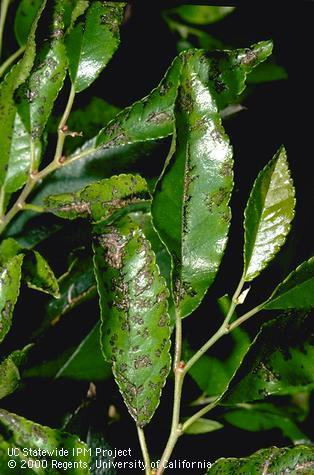
Black leaf spots caused by Chinese elm anthracnose, Stegophora ulmea, fungus. (Jack Kelly Clark)
Anthracnose is a fungal infection that affects a wide variety of trees and plants. It causes leaf spots, twig cankers, and dieback. It overwinters on the bark of the tree or on fallen leaves and is spread in the spring by rain and wind. While it will not cause permanent damage to established trees, continual years of defoliation will weaken the tree to other diseases. In order to guard against this fungus, dispose of fallen leaves to lessen the number of areas Anthracnose can survive the winter. Prune the plant of infected twigs to improve both light penetration and air circulation. Anthracnose Management Guidelines--UC IPM (ucanr.edu)
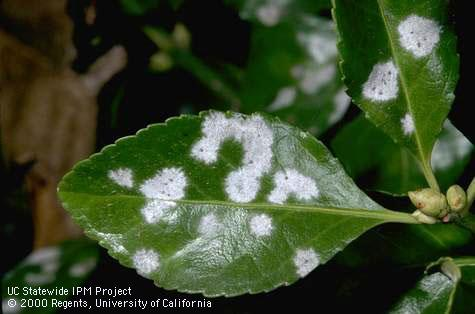
White patches of powdery mildew on euonymus leaf. (Jack Kelly Clark)
POWDERY MILDEW
A very common fungi that plagues plants is powdery mildew, covering leaves in a grey-white growth. Although it does not need water to spread, high humidity encourages spore formation of powdery mildew while low humidity aids in spore dispersal. Sunlight and heat can kill this fungus so try to place plants in sites that receive at least six hours of light a day. Do not crowd plants, as you want to ensure air can circulate adequately. Fungicides can only be used for prevention and control. There is no product that can eliminate the problem completely. Powdery Mildew--UC IPM (ucanr.edu)
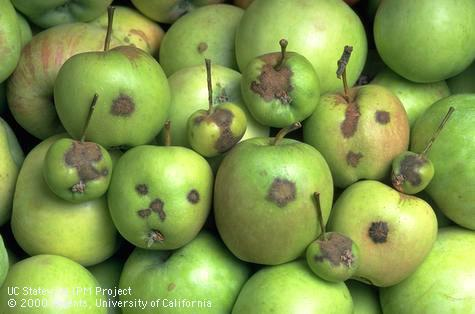
Dry, rough, distortions on fruit skin caused by apple scab fungus, Venturia inaequalis. (Jack Kelly Clark)
APPLE SCAB
Apple scab can cause serious damage to ornamental trees and shrubs. It may be found initially as fuzzy, round lesions that appear on leaves and cause them to curl. The spores are released by rainfall and can land to infect flowers, fruit, or leaves. Severely infected leaves turn yellow and drop. Some cases can lead to total defoliation for trees. As with anthracnose, these leaves should be disposed of as soon as possible. Apple and Pear Scab Management Guidelines--UC IPM (ucanr.edu)
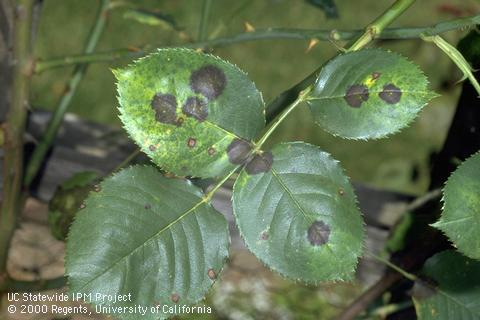
Dark blotches and yellowing on rose leaflets infected with black spot, Diplocarpon rosae fungus. (Jack Kelly Clark)
BLACK SPOT
Black spot is caused by a fungus called Diplocarpon rosae and it creates spots on foliage of ¼ inch to 1 inch in diameter. As the disease worsens, it will yellow the tissue around the black spots and cause premature leaf drop. The fungal spores are spread by rain splashing on new leaves and the fungus can develop if the area has been wet for six to nine hours. Bright sunlight and good air circulation are needed to get rid of black spot. If the plant is already infected, remove the infected material and spray with a fungicidal soap. Managing Pests in Gardens: Diseases: Black spot—UC IPM (ucanr.edu)
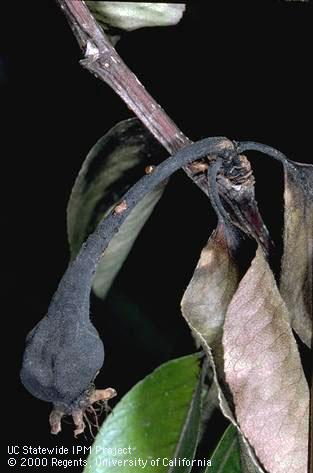
Blackened fruit and bacterial ooze are typical of fire blight infection. (Jack Kelly Clark)
FIRE BLIGHT
This disease is caused by the bacteria Erwinia amylovora. It is extremely common and affects fruit trees like apple, pear, and quince. Fire blight appears as a reddish, watery ooze coming out of a branch or trunk cankers as soon as the infected plant begins active growth. Infected flowers and stems turn brown or black and wither. The bacteria spreads through rain and pollinators. There is no cure for fire blight so the best way to control it is by pruning the cankered limbs during the dormant season. Copper products can be sprayed to reduce the bacteria’s ability to survive and reproduce. Fire Blight Management Guidelines--UC IPM (ucanr.edu)

